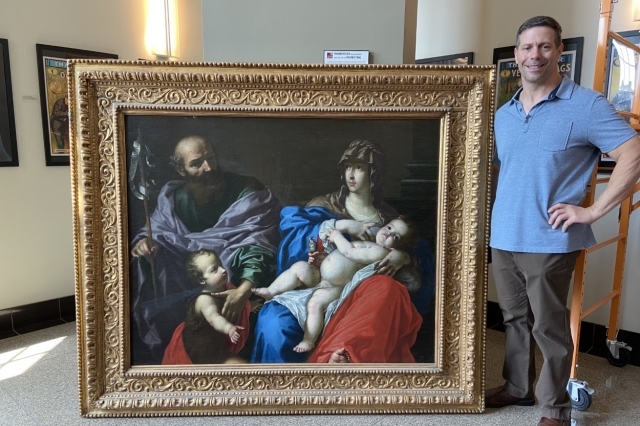
A random visit to a New Rochelle, NY, church in 2020 led an art historian to an incredible find that will be featured in a presentation at St. John’s University’s Queens, NY, campus on September 29.
As Thomas Ruggio, M.F.A., Director and Associate Professor of Visual Arts at Iona University, tells it, he walked into the Church of the Holy Family in New Rochelle in January 2020. Scanning the church while meditating, he set his eyes on a painting and immediately sensed it was a lost, 17th-century masterpiece from Italy.
Prof. Ruggio was correct. In fact, it proved to be the painting Holy Family with the Infant St. John, the third in a series of four works from elusive Baroque artist Cesare Dandini, and had been believed missing for decades.
Prof. Ruggio, from Whitestone, Queens, will tell that story and more on Thursday, September 29, in the D’Angelo Center Ballroom at 1:50 p.m. He is an expert in 16th- and 17th-century European art and has curated a host of exhibitions from the period.
“I had been in the church a few times before and never noticed the painting because the lights were always turned down—but that day I noticed it and couldn’t believe it,” Prof. Ruggio recalled. “The painting just caught my eye. It seemed out of place in a local church.”
According to Prof. Ruggio, who holds a Master of Fine Arts degree from Queens College, Holy Family with the Infant St. John was painted around the year 1630 and was one of several biblical masterpieces from the Florence, Italy-based artist who lived from 1596 to 1657. How it wound up in metropolitan New York remains a mystery.
The most likely explanation is that a former pastor at the church, Monsignor Charles Fitzgerald, purchased the painting while in Europe in the early 1960s—meaning it hung in the New Rochelle church for six decades before Prof. Ruggio spotted it.
Holy Family with the Infant St. John depicts the Virgin Mary, her husband Joseph, and the Christ child meeting St. John the Baptist, described as a cousin of Jesus in the Gospel of Luke. “The connection to the infant St. John makes this a perfect St. John’s University event,” said Amy Gansell, Ph.D., Associate Professor, Art History, Department of Art and Design, St. John’s College of Liberal Arts and Sciences.
Odd as it seems, it was not unusual for masterpieces such as Mr. Dandini’s to sell in the 1960s for a fraction of their current worth, Prof. Ruggio said. “In 1961 or so, you could buy an old master for less than you think; the market didn’t really take off until the 2000s,” he explained. “So it’s not unreasonable to think Msgr. Fitzgerald could have purchased it.”
After stumbling on to the missing masterpiece that January afternoon, Prof. Ruggio took a few cell phone pictures and sent them to colleagues in Italy and Manhattan, NY, for authentication. The identification of the find became a global story in the world of art history.
“It was a slam dunk,” Prof. Ruggio said. “Mr. Dandini had used these figures at least four other times. The authentication process was made easier by his process of reviving the figures.”
Mr. Dandini, experts say, was one of the most sought-after artists of his age, often painting religious or allegorical works for Europe’s wealthy, including the famous Medici family. He is noted for his use of bright colors and elegant compositions, according to The Metropolitan Museum of Art.
Holy Family with the Infant St. John, 46 inches wide by 57 inches deep, remains in the New Rochelle church today. The original will not be a part of Prof. Ruggio’s presentation, but he will have images of it.
A sister painting by Mr. Dandini, Charity, is housed at The Met in Manhattan; another, Holy Family, is found in the State Hermitage Museum in St. Petersburg, Russia. The location of the fourth painting is unknown.
“It’s such a great story for our St. John’s community and everyone, really,” Dr. Gansell said. “Sometimes with these master works, their origin stories seem to get lost—but they’re not lost, they’re misplaced, and sometimes they are right in front of us.”
All are invited to hear the story of Prof. Ruggio’s find. For those unable to attend, the lecture also will be livestreamed. For more information, contact Dr. Gansell at 718-990-5600 or [email protected].
